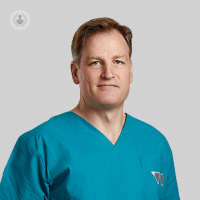Spider veins (thread veins)
Mr David Greenstein - Vascular surgery
Created on: 01-27-2017
Updated on: 12-05-2023
Edited by: Kate Forristal
What are spider veins (thread veins)?
Spider veins, also known as thread veins, are milder versions of varicose veins and are smaller, red and blue blood vessels that are visible on the surface of the skin. Their appearance resembles a spider’s web or tree branches. You will usually have them on your legs and face and they are more common in women than in men.
A vascular surgeon, dermatologist or aesthetic medicine specialist would treat spider veins.

Symptoms of spider veins:
Spider veins are usually symptomless and don’t pose a health problem, however, sometimes you might experience itchiness.
What are the causes of spider veins?
Spider veins develop when the valves in your leg veins weaken, allowing blood to flow backwards. Spider veins appear blue because the blood in them is deoxygenated. There are several factors that increase your risk of developing spider veins, including:
- Age
- Pregnancy
- Use of oral contraceptives
- Family history
- Obesity
- Sex – women are more likely to have spider veins.
- Standing up or sitting down for long periods.
Can spider veins be prevented?
Spider veins are not completely preventable, but measures to improve blood circulation can reduce the chances of them developing. The following will help:
- Maintaining a healthy weight
- Exercising regularly
- Eating a low sodium diet with lots of fibre
- Take breaks when sitting or standing for long periods
- Avoid tight trousers and high heels
Treatments for spider veins:
Taking measures to improve blood circulation and healthy lifestyle measures are the main methods of improving or reducing the number of spider veins you have and treatments or surgery are usually reserved for larger varicose veins that are either not aesthetically pleasing or have painful symptoms.
















